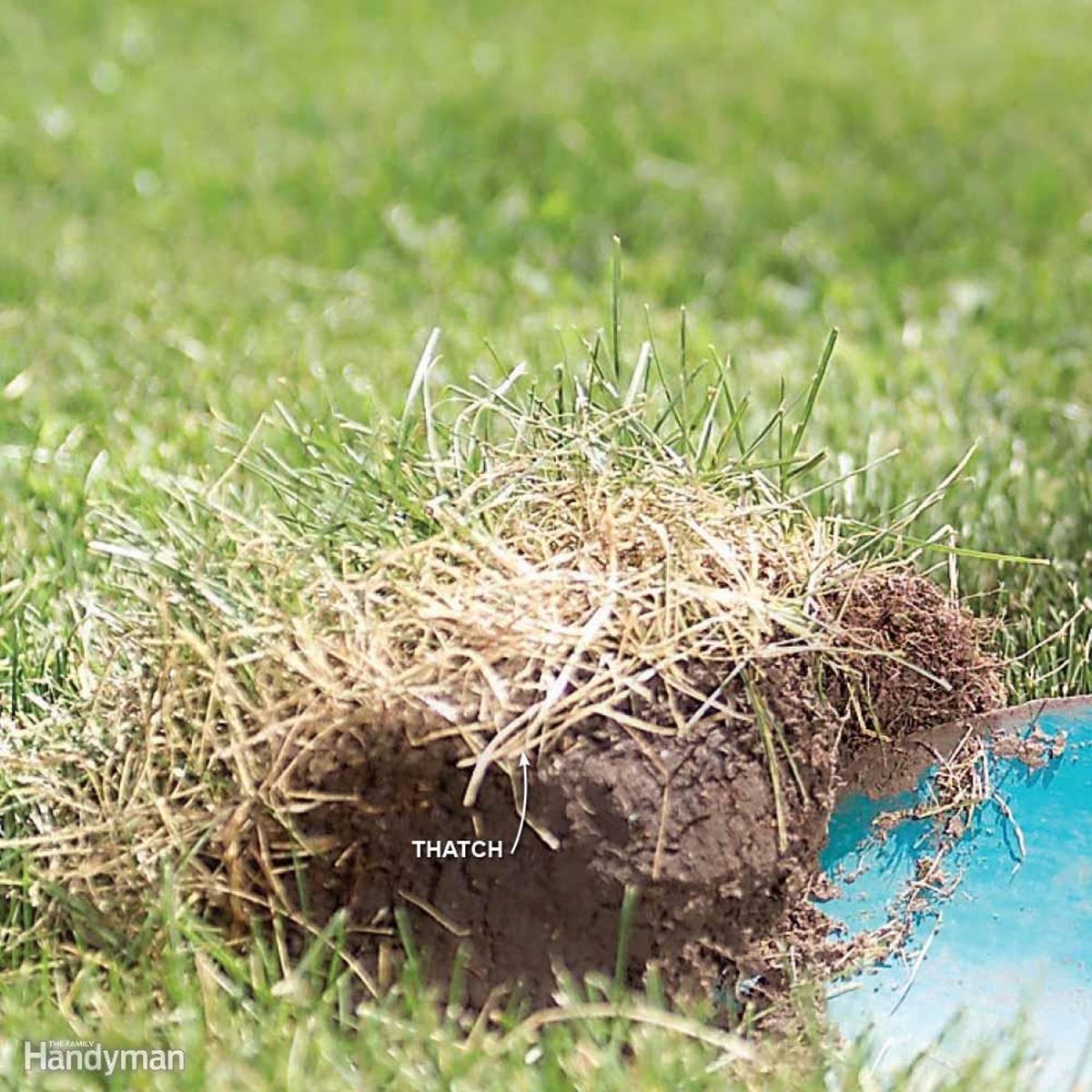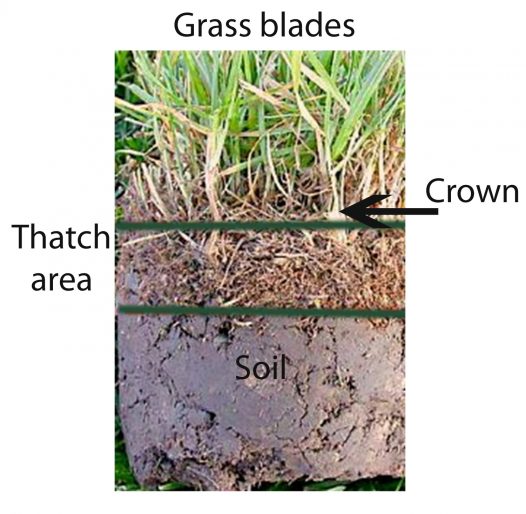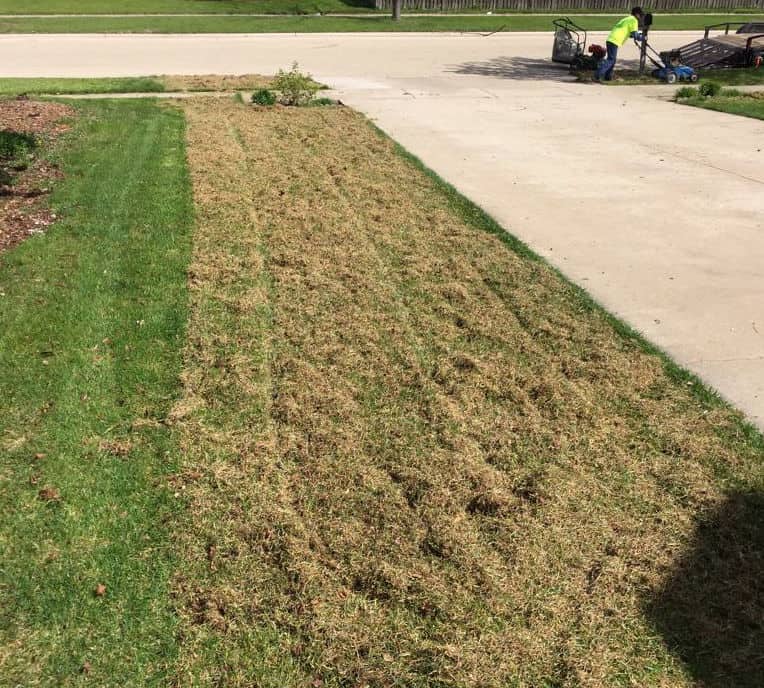When Should I Dethatch My Lawn
There are certain times when you should specifically dethatch your lawn. First make sure to always check the thatch layer and make sure it is more than 1 inch in order to dethatch.
Then make sure you are dethatching in the season according to what grass you are growing, and should coincide with the major growth times. For Kentucky bluegrass, or other cool season grasses, the early fall or late summer is the best time to dethatch. For Zoysia grass or other warm season grasses, early summer is the best time to dethatch.
The wrong time to dethatch a lawn is when your grass is stressed as this will cause major damage.
Lawn Dethatcher : Beginners Guide To Lawn Dethatching
Dethatching a lawn is a process whereby gardeners remove the thatch layer from their lawn. The objective of this is usually to make it easier for water, air and nutrients to reach the grass’s roots. It also helps with weed control and fertilization.
We’ve created this guide for beginners who want to know more about how to use a dethatcher to dethatch their own lawns in order to maintain them better. We’ve included some helpful tips on what you need before getting started, the best time of year, and an overview on how long it takes-you’ll be surprised!
Aeration: Breathe Life Into Your Lawn
The soil your lawn is growing in compresses over time. Compacted soil causes some of the same problems thatch does. The soil can become so dense water has a difficult time seeping in, grass struggles to grow, and roots gasp for air.
Aeration is the process of making holes in the lawn, which loosens the soil to improve drainage, making it easier for water, air, and fertilizer to reach the roots. It gives the roots some room to grow deeply. The result is a thicker, healthier lawn. Unfortunately, homeowners very often neglect this important maintenance practice.
There are two methods of aeration: tine or spike aeration, and core or plug aeration. Tine aeration uses tines to pierce the soil. Unfortunately, it can also further compact the soil some dont consider it to be aeration at all. Core aeration removes plugs of soil from the lawn and is the preferred method. Core aeration can also keep the thatch layer in check. Aeration equipment thats pulled behind mowers tends to be ineffective.
When heavily traveled paths on the lawn start to look weak and theres a thatch layer of an inch or more, its time to aerate. Lawns in good condition, with a half-inch or less of thatch, generally dont need to be dethatched and should only need to be aerated every other year.
Don’t Miss: How To Keep Lawn Grass Green
When And How To Dethatch Your Lawn
Ripping, tearing, slicing, slitting, cutting all sound like unpleasant things to do to a perfectly innocent lawn. But if you have a dense underlayer of thatch keeping your lawn from doing its best, then your lawn will benefit from dethatching. Well explain what thatch is, how it develops, and how to free your yard from it and keep it from returning.
Just want a dethatching tool? Here are our top picks:
Keep Your Grass Lush And Green By Dethatching It When Needed With These Lawn Tips Youll Be An Expert In No Time

Thatch is a matted layer of grass stems, roots, stolons, rhizomes, and other organic debris that builds up faster than it can decompose. Thatch accumulates immediately below the green surface of the lawnon top of the soil at the base of blades. A layer of thatch that’s less than ½ inch thick is normal and does not present cause for action. In fact, a thin layer of thatch is a good thing: It reduces soil compaction and increases tolerance for cold and heat by protecting the crown . Thatch can also reduce water loss through evaporation.
If the thatch is more than ½ inch thick though, it may cause trouble. Think of it as a layer of plastic wrap on top of the soil. Your grass will not have access to air, water, and nutrients because thatch blocks them from reaching the roots. A thick layer of thatch can harbor disease-causing insects and fungi, prolong high humidity that promotes disease, and bind or tie up pesticides. And as thatch builds, grass roots knit into the thatch layer instead of the soil, where they easily succumb to environmental stresses such as prolonged periods of hot, dry weather.
Recommended Reading: How Much To Cut My Lawn
Using The Correct Mowing Height
This fix is really only for warm season grasses like St. Augustine that grow lateral stolons and form a mat. Keeping this type of grass mowed between 3 ½ to 4 inches is good for the grass and reduces the sponginess. So, by adjusting your cutting height lever, youll be able to mow your lawn at the correct level.
What To Do After Dethatching
Dethatching tends to loosen up the soil at the base of the grass blades and reveals some bare soil where the thatch has been removed. Thus, this is a good time to overseed your lawn with additional grass seed and to apply whatever fertilizers or soil amendments that are appropriate. It’s a good idea to have a soil test done every few years and to apply whatever amendments are recommended by the testing agency. For example, your lawn may require lime to restore pH balance, or gypsum to loosen the soil and encourage good root growth.
This kind of comprehensive lawn care routine should usually include core aeration, which is best performed immediately after dethatching, but before overseeding and amendment/feeding.
Also Check: What To Wear When Mowing The Lawn
Keep The Lawn Aerated
Since thatch is composed of organic clippings from a living turfgrass, adequate aeration will decompose it. Deeply aerating your lawn soil can help prevent thatch buildup since it loosens the soil and aids soil microbial activities.
The more decomposing bacteria you have in the soil, the more the thatch decomposes and accelerated decomposition reduces the chances that thatch will build up to harmful levels.
How To Aerate Your Lawn
Read Also: Where To Buy Lawn Sprinklers
When And How Often Should You Aerate Your Lawn
Aeration of lawn doesnt have a specific number of times it can be done in a year. Neither does it have a specific date.
There are only two factors that determine when and how often you can aerate your lawns:
- The nature of the soil
You can aerate lawns once in a year if the nature of the soil is sandy soil. The aeration will only take place during the springtime.
For clay soil, you can aerate your lawn 2 4 times in a year. This number of times will enable the lawns to receive proper water, air, and nutrients to aid their growth.
You can also aerate your lawns during rainfall if there is no tender grass. Because aerating during spring might damage the tender grass roots.
Aerating during the spring will create enough time for the thatch to decompose overtime.
Especially when the spring is almost coming to an end. This process is mainly done to give the lawns more nutrients.
Another method of aeration is before the temperature reaches 55 degree celsius during the spring period. During this period you will be able to pull enough weed in your lawns.
If youre in the north, you can aerate your lawns during the early fall, while in the south you can aerate during the mid-spring to the early summer.
Final Thoughts About Controlling Annual Bluegrass In Lawns
Now that youve read this guide to identifying and eliminating the poa annua weed from your lawn, I hope you feel much more confident about and comfortable with your options to kill Poa Annua.
Understanding what youre dealing with is always the first step to coming up with a plan to address your problem.
No matter which steps you decide to take to control poa annua in your lawn, always carefully read the label and weigh the risk and benefits of using these products in your yard.
This is key to being able to control weeds without damaging your turfgrass, and without putting your pets, children, neighbors, and even yourself at risk.
Want to keep reading? You may be interested in my lawn weed identification guide.
Recommended Reading: How Much Does It Cost For Lawn Mowing Service
What Is The Best Way To Dethatch My Lawn
To dethatch your lawn, you can either do it by yourself or you contact an expert.
If you want to dethatch your lawn by yourself, just get a rake and a dethatcher to get the work done.
Get a work-glove to wear on your hands.
Use the dethatcher to get the environment ready and use the rake to gather the thatch. After the gathering, pick up the thatch to put them in the garbage bag.
Can Dethatching Hurt Your Lawn

Dethatching your lawn can be hard on certain grass types like tall fescue or rye grass. These bunch type grasses dont have the ability to recover as quickly as kentucky bluegrass or bermuda grass from dethatching. It is best to plan to overseed after dethatching tall fescues and rye grass.
If you plan on putting down a preemergent or crabgrass preventer on your lawn and also need to dethatch, it is best to dethatch first. Dethatching after you put down your weed preventers and preemergent will disturb the barrier that was created.
Don’t Miss: How To Get Lines In Your Lawn
How Tee Time Lawn Care Can Help
Now that you know aeration is the right choice for your lawn, you may also be debating on aerating on your own or hiring a lawn care service. Many homeowners discover that hiring a professional is not much more costly than doing it themselves. Tee Time Lawn Care will give you the confidence that the aeration is performed correctly and giving your lawn the best results. To keep your lawn looking its best, visit our Tee Time Lawn Care aeration service page to get a quote.
Scarify And Rake Your Lawn
Scarifying and raking physically removes thatch, dead foliage and moss from your lawn.
Scarifying is important as it removes thatch from around the base of the grass plants which allows are, water and nutrients back into the soil.
Raking controls the build-up of thatch by removing dead foliage and growth from the surface.
The best scarifiers often have changeable cartridges with vertical blades for dislodging thatch and spring tines for controlling thatch and moss from above the surface.
Its important that you choose the right time to scarify and this guide shows you how to scarify a lawn, step-by-step.
Also Check: How Do You Clean Plastic Lawn Furniture
Dethatching With A Power Rake
Power rakes are similar to walk-behind lawn mowers and have rotating tines that slice into the grass/turf. These tines dig into the thatch and go all the way into the soil to pull pieces up and loosen/rake your lawn thatch, bringing it to the surface of your lawn.
These power rakes are mainly good for thin layers of thatch. Power rakes are not a great option for sensitive or young grass. You would want to use this on strong grass that you arent worried to rip out, and I usually recommend overseeding afterward.
Most people who use a power rake will rent a professional one from their local hardward store or box store, but you can purchase one if you know youll be detatching your lawn pretty regularly.
My Lawn Dethatcher Setup
I personally own this Greenworks Dethatcher, and it works really well. I dont like that its corded, but I own a Dewalt portable power station, so when its time to dethatch my yard I just strap that on top, and plug the Greenworks power rake right into that which makes it cord-free, running on my Dewalt batteries.
Im really happy with this set-up, but I probably wouldnt recommend the Greenworks Dethatcher to someone with a large yard who doesnt have a battery-powered generator setup like mine. Dragging a cord around a big yard can be frustrating.
If you have a small yard, the Greenworks tool is a great value and probably a better option than renting.
Excess Buildup Of Thatch In The Lawn
Certain lawn types create excessive thatch. Grasses like Kentucky bluegrass, creeping bentgrass, and creeping red fescue are just a few grasses that have thatch build-up over the growing season.
Even though thatch is a natural part of your lawn growing process and helps control things like soil temperature and moisture retention, and adds natural nutrients to your lawn, it does give the feeling that your lawn is sinking. So, dig into your grass to see how much thatch you have. If it looks like there is a lot, then youll want to use a method to dethatch your lawn.
Also Check: How To Restore Lawn From Weeds
What Is Lawn Aeration
Lawn aeration, coring, and aerifying are different terms you might hear for the same procedure. A core aerator removes plugs of soil from your lawn, which helps loosen compacted soil and allows vital air, water, and nutrients to reach the roots. You can either aerate your lawn yourself or call a lawn service. If you plan to DIY, rent an aerator and follow these tips.
Is Poa Annua Weed A Perennial Or Annual Weed
While poa annua is an annual weed, the seeds are incredibly resilient. In fact, they may exist dormant in a lawns soil for several years, waiting for favorable conditions.
As long as the seed stays viable, this weed can start growing as soon as conditions are right.
Given this reality, youll probably have to go through two steps to get rid of poa annua in your lawn.
In most cases, youll have to use post-emergent weed killers as well as pre-emergent lawn herbicides if youre serious about permanently getting rid of poa annua weed in your lawn.
Its the fact that hot temperatures make poa annua die back and turn brown that makes it such a problem for many homeowners.
In some cases, you may not even notice the problem until the brown spots appear. You may even have empty spots on your lawn.
One of the trickiest aspects of poa annual is how it starts growing more when the weather is cool. After all, this is when your turfgrass wont be resilient.
In fact, it will probably be dying back and the soil will be more susceptible to being overtaken by weed growth, including poa annua.
Don’t Miss: Do It Yourself Lawn Care
Beginners Guide To Lawn Dethatching
- Beginners Guide To Lawn Dethatching
Lawn dethatching can be crucial to keeping your grass and soil healthy. Even if you are mowing and doing everything else necessary for your lawn, thatch can build up. Over watering and over fertilization can cause excess thatch. Detaching removes the thick layer of dead plant material . This allows air, water, and nutrients to reach your plants and soil again. Dethatching allows your lawn to drain better as well. By learning why dethatching is important, as well as when and how to dethatch, it will be easier to keep your lawn healthy.
Dethatcher Vs Aerator What Do They Mean

Homeowners often confuse dethatching and aeration because they sound similar on paper. Both procedures remove the excess matter from the soil to allow the roots and grass to breathe and receive nutrition freely. However, they are two different techniques that help your lawn in different ways. Heres a brief explanation about aeration and dethatching.
- Dethatching Process Thatch is the natural organic matter that falls on the soil surface. This includes leaves, grass clippings, flowers and fruit from nearby trees, etc. It is useful when present in moderate amounts, as it keeps the soil moist and constantly supplies nutrients to it. Thatch can also protect the soil from extreme temperature changes so a healthy layer of it is useful. However, if the layer is too thick, it can form a barrier between the soil and air outside. That will suffocate the roots and kill the grass. The dethatching process removes the excess thatch and ensures that only a healthy layer remains on the surface.
- Aeration Process Your lawns soil can become compacted over time due to pressure, weight, and gravity. This can make the surface hard, which can compress the roots and stifle them. A professional landscaper can help you avoid this with a thorough aeration service. Through this process, you can remove small plugs of soil from the surface and allow the remainder of it to breathe. Aeration helps release the pressure and loosens the soil, which allows the grass roots to grow and spread.
Also Check: Is It Too Late To Seed My Lawn